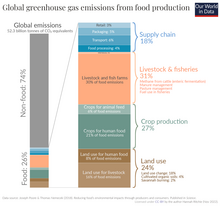
Back انبعاثات غازات الدفيئة من الزراعة Arabic কৃষি থেকে গ্রিনহাউস গ্যাস নির্গমন Bengali/Bangla دەردانی گازی گەرمخانەیی لە وەرزێری CKB Emise skleníkových plynů ze zemědělství Czech Emisiones de gases de efecto invernadero procedentes de la agricultura Spanish نشر گازهای گلخانهای در کشاورزی Persian Емисии на стакленички гасови од земјоделството Macedonian د کرنې له امله د ګلخانهيي ګازونو خپرېدل Pashto/Pushto Ibyuka bihumanya ikirere biva mu buhinzi Kinyarwanda Go ntshiwa ga digase tse di bakang go gotela ga lefatshe go tswa mo temothuong Setswana

The amount of greenhouse gas emissions from agriculture is significant: The agriculture, forestry and land use sector contribute between 13% and 21% of global greenhouse gas emissions.[2] Emissions come from direct greenhouse gas emissions (for example from rice production and livestock farming).[3] and from indirect emissions. With regards to direct emissions, nitrous oxide and methane make up over half of total greenhouse gas emission from agriculture.[4] Indirect emissions on the other hand come from the conversion of non-agricultural land such as forests into agricultural land.[5][6] Furthermore, there is also fossil fuel consumption for transport and fertilizer production. For example, the manufacture and use of nitrogen fertilizer contributes around 5% of all global greenhouse gas emissions.[7] Livestock farming is a major source of greenhouse gas emissions.[8] At the same time, livestock farming is affected by climate change.
Farm animals' digestive systems can be put into two categories: monogastric and ruminant. Ruminant cattle for beef and dairy rank high in greenhouse gas emissions. In comparison, monogastric, or pigs and poultry-related foods, are lower. The consumption of the monogastric types may yield less emissions. Monogastric animals have a higher feed-conversion efficiency, and also do not produce as much methane.[9] Non-ruminant livestock, such as poultry, emit far fewer greenhouse gases.[10]
There are many strategies to reduce greenhouse gas emissions from agriculture (this is one of the goals of climate-smart agriculture). Mitigation measures in the food system can be divided into four categories. These are demand-side changes, ecosystem protections, mitigation on farms, and mitigation in supply chains. On the demand side, limiting food waste is an effective way to reduce food emissions. Changes to a diet less reliant on animal products such as plant-based diets are also effective.[11]: XXV This could include milk substitutes and meat alternatives. Several methods are also under investigation to reduce the greenhouse gas emissions from livestock farming. These include genetic selection,[12][13] introduction of methanotrophic bacteria into the rumen,[14][15] vaccines, feeds,[16] diet modification and grazing management.[17][18][19]
- ^ "Food production is responsible for one-quarter of the world's greenhouse gas emissions". Our World in Data. Retrieved 20 July 2023.
- ^ Nabuurs, G-J.; Mrabet, R.; Abu Hatab, A.; Bustamante, M.; et al. "Chapter 7: Agriculture, Forestry and Other Land Uses (AFOLU)" (PDF). Climate Change 2022: Mitigation of Climate Change. p. 750. doi:10.1017/9781009157926.009..
- ^ Steinfeld H, Gerber P, Wassenaar T, Castel V, Rosales M, de Haan C (2006). Livestock's long shadow: environmental issues and options (PDF). Food and Agriculture Organization of the UN. ISBN 978-92-5-105571-7. Archived from the original (PDF) on 25 June 2008.
- ^ FAO (2020). Emissions due to agriculture. Global, regional and country trends 2000–2018 (PDF) (Report). FAOSTAT Analytical Brief Series. Vol. 18. Rome. p. 2. ISSN 2709-0078.
- ^ Section 4.2: Agriculture's current contribution to greenhouse gas emissions, in: HLPE (June 2012). Food security and climate change. A report by the High Level Panel of Experts (HLPE) on Food Security and Nutrition of the Committee on World Food Security. Rome, Italy: Food and Agriculture Organization of the United Nations. pp. 67–69. Archived from the original on 12 December 2014.
- ^ Sarkodie, Samuel A.; Ntiamoah, Evans B.; Li, Dongmei (2019). "Panel heterogeneous distribution analysis of trade and modernized agriculture on CO2 emissions: The role of renewable and fossil fuel energy consumption". Natural Resources Forum. 43 (3): 135–153. doi:10.1111/1477-8947.12183. ISSN 1477-8947.
- ^ "Carbon emissions from fertilizers could be reduced by as much as 80% by 2050". Science Daily. University of Cambridge. Retrieved 17 February 2023.
- ^ "How livestock farming affects the environment". www.downtoearth.org.in. Retrieved 10 February 2022.
- ^ Friel, Sharon; Dangour, Alan D.; Garnett, Tara; et al. (2009). "Public health benefits of strategies to reduce greenhouse-gas emissions: food and agriculture". The Lancet. 374 (9706): 2016–2025. doi:10.1016/S0140-6736(09)61753-0. PMID 19942280. S2CID 6318195.
- ^ "The carbon footprint of foods: are differences explained by the impacts of methane?". Our World in Data. Retrieved 14 April 2023.
- ^ United Nations Environment Programme (2022). Emissions Gap Report 2022: The Closing Window — Climate crisis calls for rapid transformation of societies. Nairobi.
- ^ "Bovine Genomics | Genome Canada". www.genomecanada.ca. Archived from the original on 10 August 2019. Retrieved 2 August 2019.
- ^ Airhart, Ellen. "Canada Is Using Genetics to Make Cows Less Gassy". Wired – via www.wired.com.
- ^ "The use of direct-fed microbials for mitigation of ruminant methane emissions: a review".
- ^ Parmar, N.R.; Nirmal Kumar, J.I.; Joshi, C.G. (2015). "Exploring diet-dependent shifts in methanogen and methanotroph diversity in the rumen of Mehsani buffalo by a metagenomics approach". Frontiers in Life Science. 8 (4): 371–378. doi:10.1080/21553769.2015.1063550. S2CID 89217740.
- ^ "Kowbucha, seaweed, vaccines: the race to reduce cows' methane emissions". The Guardian. 30 September 2021. Retrieved 1 December 2021.
- ^ Boadi, D (2004). "Mitigation strategies to reduce enteric methane emissions from dairy cows: Update review". Can. J. Anim. Sci. 84 (3): 319–335. doi:10.4141/a03-109.
- ^ Martin, C. et al. 2010. Methane mitigation in ruminants: from microbe to the farm scale. Animal 4 : pp 351-365.
- ^ Eckard, R. J.; et al. (2010). "Options for the abatement of methane and nitrous oxide from ruminant production: A review". Livestock Science. 130 (1–3): 47–56. doi:10.1016/j.livsci.2010.02.010.
© MMXXIII Rich X Search. We shall prevail. All rights reserved. Rich X Search